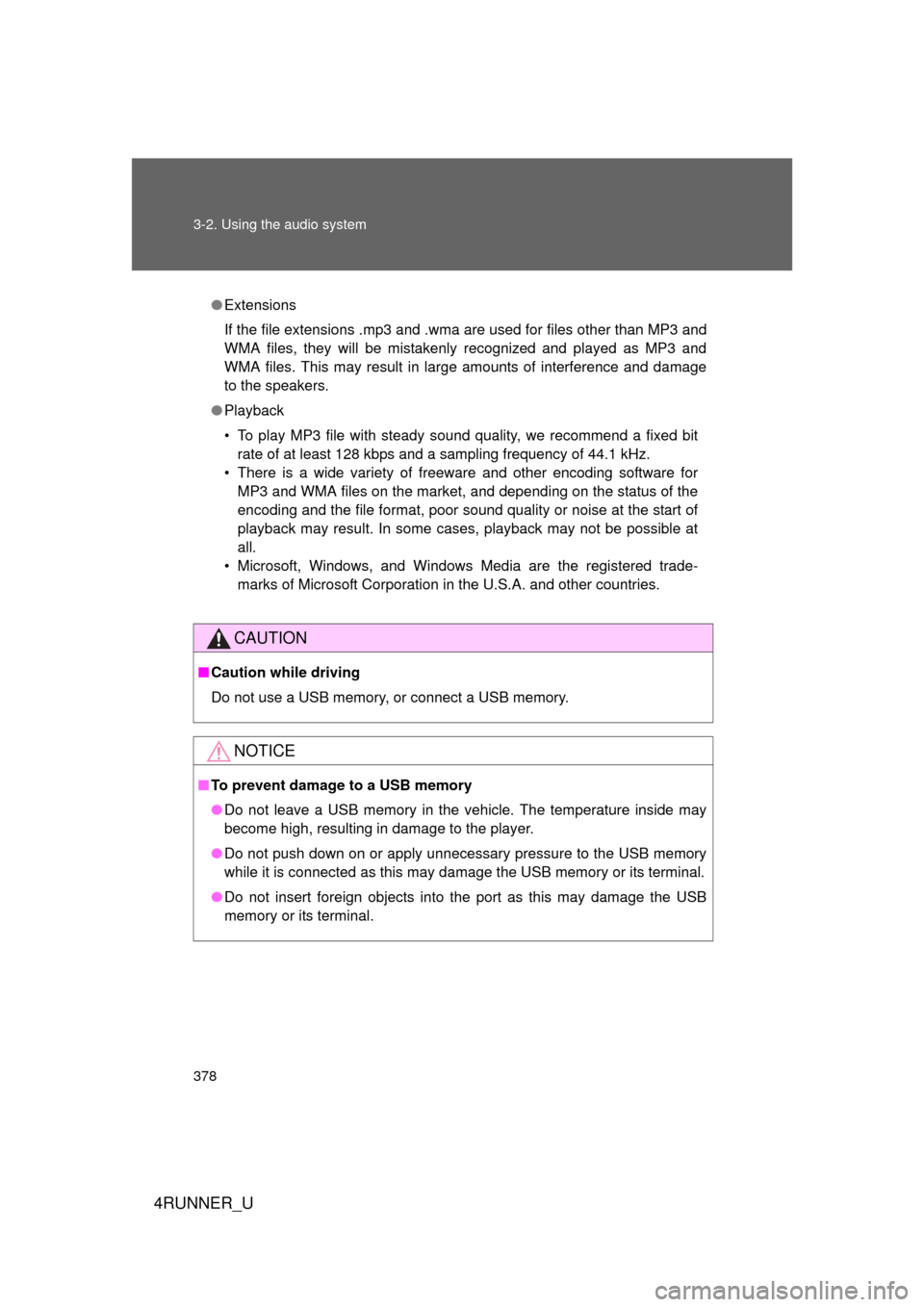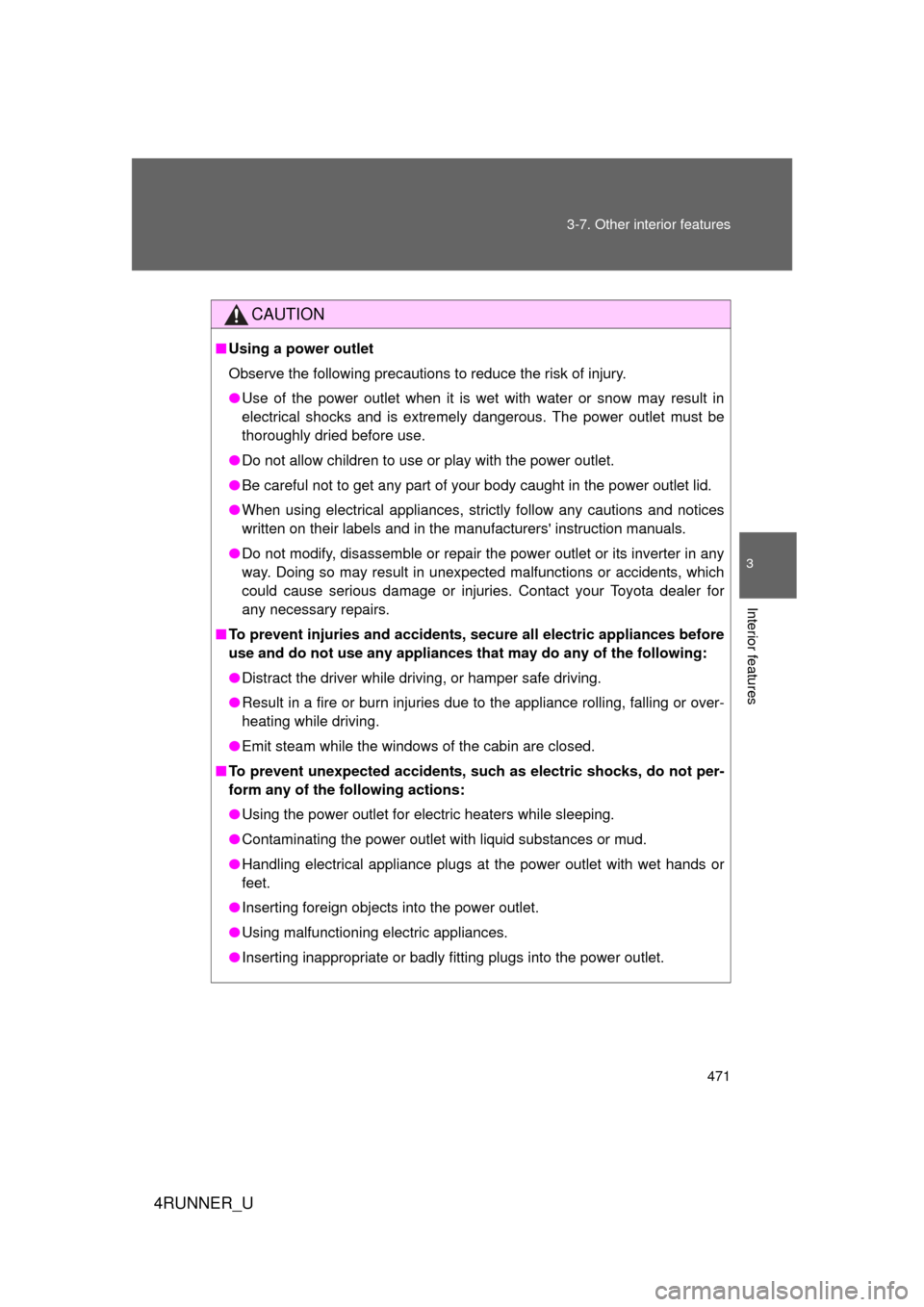Page 376 of 704

376 3-2. Using the audio system
4RUNNER_U
■USB memory
● Compatible device
USB memories that can be used for MP3 and WMA playback.
Depending on the type of USB device, playback may not be possible.
● Compatible device formats
The following device formats can be used:
• USB communication formats: USB2.0 FS (12 mbps)
• File formats: FAT16/32 (Windows)
• Correspondence class: Mass storage class
MP3 and WMA files written in any format other than those listed above
may not play correctly, and their file names and folder names may not
be displayed correctly.
Items related to standards and limitations are as follows:
• Maximum directory hierarchy: 8 levels
• Maximum number of folder in device: 999 (including the root)
• Maximum number of files in device: 65025
• Maximum number of files per folder: 255
● MP3 and WMA files
MP3 (MPEG Audio LAYER 3) is a standard audio compression format.
Files can be compressed to approximately 1/10 of their original size using
MP3 compression.
WMA (Windows Media Audio) is a Microsoft audio compression format.
This format compresses audio data to a size smaller than that of the MP3
format.
There is a limit to the MP3 and WMA file standards that can be used and to
the media/formats on which the files are recorded.
Page 378 of 704

378 3-2. Using the audio system
4RUNNER_U
●Extensions
If the file extensions .mp3 and .wma are used for files other than MP3 and
WMA files, they will be mistakenly recognized and played as MP3 and
WMA files. This may result in large amounts of interference and damage
to the speakers.
● Playback
• To play MP3 file with steady sound quality, we recommend a fixed bit
rate of at least 128 kbps and a sampling frequency of 44.1 kHz.
• There is a wide variety of freeware and other encoding software for MP3 and WMA files on the market, and depending on the status of the
encoding and the file format, poor sound quality or noise at the start of
playback may result. In some cases, playback may not be possible at
all.
• Microsoft, Windows, and Windows Media are the registered trade- marks of Microsoft Corporation in the U.S.A. and other countries.
CAUTION
■Caution while driving
Do not use a USB memory, or connect a USB memory.
NOTICE
■To prevent damage to a USB memory
● Do not leave a USB memory in the vehicle. The temperature inside may
become high, resulting in damage to the player.
● Do not push down on or apply unnecessary pressure to the USB memory
while it is connected as this may damage the USB memory or its terminal.
● Do not insert foreign objects into the port as this may damage the USB
memory or its terminal.
Page 470 of 704
470 3-7. Other interior features
4RUNNER_U
■If the protection circuit is activated and the power supply is cut, con-
duct the following procedure:
Park the vehicle in a safe place, and then securely apply the park-
ing brake.
Check and ensure that the shift lever is in P or N.
Make sure that the power consumption of the electric appliance is
within the maximum capacity of the power outlet and the appliance
is not broken.
Press the power outlet main switch again.
When the cabin temperature is high, open the windows to cool the tempera-
ture down. Once it reaches the normal temperature, turn the power outlet\
main switch on again.
If the power supply does not resume even after the above procedure has
been performed, have the vehicle inspected by your Toyota dealer.
STEP 1
STEP 2
STEP 3
STEP 4
Page 471 of 704

471
3-7. Other interior features
3
Interior features
4RUNNER_U
CAUTION
■
Using a power outlet
Observe the following precautions to reduce the risk of injury.
● Use of the power outlet when it is wet with water or snow may result in
electrical shocks and is extremel y dangerous. The power outlet must be
thoroughly dried before use.
● Do not allow children to use or play with the power outlet.
● Be careful not to get any part of your body caught in the power outlet lid.
● When using electrical appliances, strictly follow any cautions and notices
written on their labels and in the manufacturers' instruction manuals.
● Do not modify, disassemble or repair the power outlet or its inverter in any
way. Doing so may result in unexpected malfunctions or accidents, which
could cause serious damage or injuries. Contact your Toyota dealer for
any necessary repairs.
■ To prevent injuries and accidents, secure all electric appliances before
use and do not use any appliances th at may do any of the following:
● Distract the driver while driving, or hamper safe driving.
● Result in a fire or burn injuries due to the appliance rolling, falling or over-
heating while driving.
● Emit steam while the windows of the cabin are closed.
■ To prevent unexpected accidents, such as electric shocks, do not per-
form any of the following actions:
● Using the power outlet for electric heaters while sleeping.
● Contaminating the power outlet with liquid substances or mud.
● Handling electrical appliance plugs at the power outlet with wet hands or
feet.
● Inserting foreign objects into the power outlet.
● Using malfunctioning electric appliances.
● Inserting inappropriate or badly fitting plugs into the power outlet.
Page 508 of 704

508
4RUNNER_U
4-1. Maintenance and care
Cleaning and protecting the vehicle exterior
■Automatic car washes
● Fold the mirrors and remove the detachable pole antenna before wash-
ing the vehicle. Start washing from the front of the vehicle. Make sure to
re-install the antenna and extend the mirrors before driving.
● Brushes used in automatic car washes may scratch the vehicle surface
and harm your vehicle’s paint.
● In certain automatic car washes, the roof antenna (if equipped) or rear
spoiler may interfere with machine operation. This may prevent the vehi-
cle from being cleaned properly or result in damage to the antenna or
rear spoiler.
■ High pressure car washes
● Do not allow the nozzles of the car wash to come within close proximity
of the windows.
● Before using the car wash, check that the fuel filler door on your vehicle
is closed properly.
Perform the following to protect the vehicle and maintain it in prime
condition:
● Working from top to bottom, liber ally apply water to the vehicle
body, wheel wells and underside of the vehicle to remove any
dirt and dust.
● Wash the vehicle body using a sponge or soft cloth, such as a
chamois.
● For hard-to-remove marks, use car wash soap and rinse thor-
oughly with water.
● Wipe away any water.
● Wax the vehicle when the waterproof coating deteriorates.
If water does not bead on a clean surface, apply wax when the vehi-
cle body is cool.
Page 513 of 704

513
4-1. Maintenance and care
4
Maintenance and care
4RUNNER_U
NOTICE
■
Cleaning detergents
● Do not use the following types of detergent, as they may discolor the vehi-
cle interior or cause streaks or damage to painted surfaces:
• Non-seat portions: Organic substances such as benzene or gasoline,
alkaline or acidic solutions, dye, and bleach.
• Seats: Alkaline or acidic solutions, such as thinner, benzene, and alco- hol.
● Do not use polish wax or polish cleaner. The instrument panel’s or other
interior part’s painted surface may be damaged.
■ Preventing damage to leather surfaces
Observe the following precautions to avoid damage to and deterioration o\
f
leather surfaces:
● Remove any dust or dirt from leather surfaces immediately.
● Do not expose the vehicle to direct sunlight for extended periods of time.
Park the vehicle in the shade, especially during summer.
● Do not place items made of vinyl, plastic, or containing wax on the uphol-
stery, as they may stick to the leather surface if the vehicle interior heats
up significantly.
■ Water on the floor
Do not wash the vehicle floor with water.
Vehicle systems such as the audio system may be damaged if water comes
into contact with electrical components such as the audio system above or
under the floor of the vehicle. Water may also cause the body to rust.
■ Cleaning the inside of the back window
● Do not use glass cleaner to clean the back window, as this may cause
damage to the rear window defogger heater wires. Use a cloth dampened
with lukewarm water to gently wipe the window clean. Wipe the window in
strokes running parallel to the heater wires.
● Be careful not to scratch or damage the heater wires.
Page 564 of 704
564 4-3. Do-it-yourself maintenance
4RUNNER_U
Fuse layout and amperage ratings■ Engine compartment
FuseAmpereCircuit
1PTC HTR NO.330 A
PTC heater
2DEF30 ARear window defogger
3DEICER 20 A
Windshield wiper de-icer
4AIR PMP HTR10 AAir pump heater, AI combina-
tion valve
5PTC HTR NO.230 A
PTC heater
6SUB BATT30 ATrailer sub battery
7PTC HTR NO.150 A
PTC heater
8MIR HTR10 AOutside rear view mirror defog-
gers
9TOWING TAIL30 A
Trailer tail light
10A/C COMP10 AAir conditioning system
11STOP10 A
Stop/tail lights
12IG220 AINJ, IGN, GAUGE fuses
13HORN10 AHorn(s)
14EFI 25 AMultiport fuel injection system/
sequential multiport fuel injec-
tion system
CTH43AS146
Page 567 of 704
567
4-3. Do-it-yourself maintenance
4
Maintenance and care
4RUNNER_U
■
Driver’s side instrument panel
FuseAmpereCircuit
1TA I L10 A Stop/tail lights
2PA N E L7.5 A Instrument panel lights
3GAUGE7.5 A Meter and gauge
4IGN10 A Multiport fuel injection system/
sequential multiport fuel injec-
tion system, air bag system,
smart key system
5WASHER20 A Wiper and washer
6WIP30 A Wiper and washer
7S/ROOF 25 A Electric moon roof
8DOOR RR25 A Power windows
9DOOR D25 A Power windows
10DOOR BACK30 A
Multiplex communication sys-
tem
11DOOR P30 A Power windows
12P/SEAT FR 30 A Front passenger's power seat
13S/HTR FR 20 A Seat heater system
14ECU-IG NO.210 AAir conditioning system, multi-
port fuel injection system/
sequential multiport fuel injec-
tion system
15IG17.5 A
Turn signal lights, emergency
flashers
16ECU-IG NO.110 AVehicle stability control sys-
tem, tire pressure warning sys-
tem, steering sensor
17DOOR7.5 A Power windows